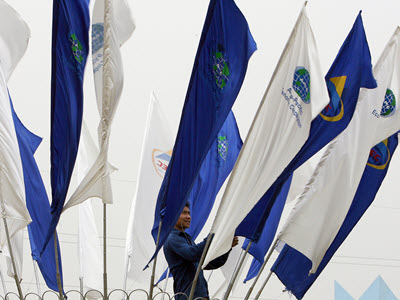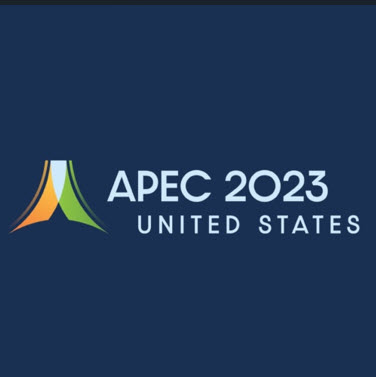APEC 2023: Challenges and Opportunities in the United States’ Host Year
Former U.S. ambassador for APEC Kurt Tong provides an overview of the past two U.S.-hosted APEC meetings and suggests several important steps forward that the United States can take as host and chair of APEC in 2023.
NBR is grateful to the Hinrich Foundation for their generous support of this publication.
The United States is currently hosting and chairing the Asia-Pacific Economic Cooperation (APEC) forum for the third time. The circumstances and objectives for Washington officials in 2023, however, are remarkably different from the situation in 1993 and 2011, when Presidents Bill Clinton and Barack Obama, respectively, chaired the 21-member body.
APEC is a unique organization that resembles the G-20, with its annual leadership rotating among nations that volunteer to host (and cover much of the cost for) each year’s activities, gaining the power to set the agenda as chair in return. But APEC is also akin to the Paris-based Organization for Economic Cooperation and Development (OECD), managing numerous standing committees that oversee substantive economic policy workstreams that can stretch over many years. These workstreams typically result in nonbinding agreements regarding best practices or policy alignment in areas such as customs facilitation, energy policy, healthcare systems, and services regulation.
At times, APEC has served as a policy sandbox generating globally significant trade policy outcomes such as the Information Technology Agreement—the first tariff liberalization, covering a wide range of high-tech products, negotiated under the auspices of the World Trade Organization (WTO)—and the Comprehensive and Progressive Agreement for Trans-Pacific Partnership (CPTPP) trade agreement—the massive Indo-Pacific free-trade deal that was the successor to the Trans-Pacific Partnership (TPP) agreement that the United States led negotiations on and then abandoned due to the domestic politics of globalization.
APEC is also a critical annual venue for regional and global diplomacy. Each year’s APEC Economic Leaders’ Meeting pulls together leaders from nations such as China, Russia, Japan, South Korea, Australia, and Canada, creating a major confab for geopolitical jousting and alliance building. APEC and the WTO are also the only multilateral organizations in which Taiwan and Hong Kong are full members alongside China. All of these geopolitical and strategic debates are amplified by the fact that APEC operates as a consensus-based organization on all decisions.
In 1993, APEC was a fledgling organization, only four years old, and Bill Clinton decided to be the first APEC leader to elevate the year’s final meeting to the head-of-government level. In those days, the United States had only recently thrown its weight behind the organization, with a goal of tying the North American economy more tightly to the rapidly expanding economies of East Asia—and simultaneously preventing the East Asian economies from assembling themselves into a group that could exclude the United States. As such, it was both a tense and a hopeful time. China was a newly admitted member of APEC, and President Clinton welcomed China’s president Jiang Zemin and the other leaders to a retreat on Blake Island near Seattle, marking a new chapter in U.S.-China relations following the 1989 Tiananmen massacre. The next year, the APEC members announced their ambitious Bogor Goals of achieving “free and open” trade and investment in the region by 2010 for developed economies and by 2020 for developing countries.
By the time the United States hosted APEC again, eighteen years later in 2011, there was growing concern about China’s regional role in geopolitics and the economy. Some members saw mostly opportunity in China’s steady and rapid economic growth, while others (including the United States) worried out loud about its disruption of the regional balance of power and increasingly obvious unwillingness to play by the liberal economic rules that were so often enshrined in APEC policy statements.
Nevertheless, Washington remained determined to use its economic power mainly as a magnet rather than a cudgel. The two major subtexts of APEC’s impressive policy achievements in 2011 were the consummation of a high-standard free trade agreement (FTA) between the United States and South Korea and the deepening and expansion of a TPP agreement modeled after the U.S.-Korea pact and newly including Japan, Canada, and Mexico. The APEC leaders themselves announced useful joint pledges on trade facilitation, environmental trade liberalization, limits on fossil fuel subsidies, and regulatory harmonization and transparency. President Obama gathered the APEC leaders in his childhood hometown of Honolulu and claimed important progress in a long-term U.S. effort to “lead the way toward a more seamless regional economy with more trade, more exports, and more jobs for our people.” At his concluding press conference, with the gentle waves of the Pacific Ocean lapping behind him, Obama exuded optimism and a sense of positive forward motion in bringing the APEC economies closer together.
Now, in 2023, however, after a dozen years that witnessed ever more apparent exceptionalism in China’s economic policy approaches as well as major pandemic-related disruptions to global supply chains, the APEC region’s economic policy mood is much more pessimistic and defensive. In recent years, the United States has taken the lead again, but this time by closing doors rather than opening them.
President Donald Trump withdrew the United States from the TPP—which went ahead regardless as the CPTPP thanks to Japan’s leadership—and then increased tariffs on imports from China as part of an unsuccessful grand economic negotiation with Beijing. Under President Joe Biden’s leadership, the United States has concentrated its attention on thwarting China’s technological advancement, while launching the Indo-Pacific Economic Framework (IPEF) initiative with friendly Asian nations that most participants consider to carry less economic significance than the CPTPP or the fifteen-member Regional Comprehensive Economic Partnership, which includes China. Meanwhile, China and Russia have become active spoilers within APEC itself, blocking consensus on a number of useful and technocratic initiatives that were earnestly shepherded by Malaysia, New Zealand, and Thailand in their recent host years. China’s obstructionism even extended to unprecedentedly blocking the joint statement of the APEC Economic Leaders’ Meeting in 2018 over the Trump administration’s tariffs.
Looking at the U.S. political landscape in 2023, it is hard to be optimistic about this year’s APEC meetings generating the kind of enthusiastic optimism that U.S. leadership prompted in 2011. President Biden’s approach to trade policy has been narrow and defensive, and the White House has barely spoken about its APEC goals.
Meanwhile, geopolitical mousetraps lurk below the surface, ready to undermine the year’s agenda. Beijing, for example, will need to gauge how much water it carries for Vladimir Putin’s Russia in APEC, even as it worries that the United States might embarrass Xi Jinping by diverging from the delicate protocol that enables both China and Taiwan to participate (whereby Taiwan sends a private sector representative rather than its president). China is also worried about whether the White House will respect precedent and invite Hong Kong’s chief executive John Lee to APEC, even though Lee is under U.S. legal sanction for having implemented Beijing’s national security law in Hong Kong.
If the bad news is that the United States is no longer a sincere and vocal leader supporting APEC’s original core mission of “regional economic integration,” is there any good news about Washington’s stewardship of APEC in 2023? The good news is that the United States has a highly capable economic policy and foreign policy bureaucracy that can—with proper encouragement from the White House—pivot to use APEC’s inherent flexibility, as well as the power of the APEC chair, to achieve important substantive policy outcomes in areas other than trade liberalization. Other good news is that Asian leaders very much want to engage more deeply with U.S. private corporations, which they continue to see as critical sources of capital and technology for their nations’ social and economic advancement.
U.S. APEC senior official Matt Murray has outlined themes for 2023 that are timeless and attractive, including the promotion of green growth, digital connectivity, and social inclusion. There are several important steps forward that the United States could orchestrate in each of these areas:
- In coordination with the IPEF initiative, APEC could build a public-private clearinghouse for green energy projects linking technology suppliers with technology buyers and identifying those projects for “green finance” providers in the region’s financial centers.
- APEC could support the development of an efficient and healthy digital economy and promote the involvement of smaller companies in e-commerce and cross-border digitalized business lines by crafting a set of principles that draws from Japan’s ideas on “digital free flow with trust” and the Singapore-led Digital Economy Partnership Agreement.
- APEC could also take major strides on social inclusion and educational advancement. Meeting in San Francisco in November, the APEC leaders could reissue the 2011 minister-level San Francisco Declaration on women and the economy—this time requiring specific pledges on women’s economic participation made at the APEC leaders’ level. Another powerful idea on this front would be to strengthen the region’s network of universities by establishing an APEC-run consortium for expanded academic exchange and cross-recognition of academic credentials in certain fields.
- In addition, on the institutional front, the United States could take steps to further integrate the role of business, labor, and civil society groups into APEC’s deliberations. The private sector–led APEC CEO Summit organized on the margins of the APEC Economic Leaders’ Meeting is certain to be a lively event. In addition to highlighting U.S. technology and business approaches, the summit could usefully highlight the role of social inclusion in U.S. corporate philosophy. At the same time, the U.S. APEC team could strengthen public-private cooperation mechanisms within APEC itself—for example, by reconstituting the Life Sciences Innovation Forum.
- Meanwhile, and quietly, the United States’ foreign policy professionals could work far in advance of the high stakes end-of-year meetings to reach an understanding with China that the United States will follow established APEC precedent on political matters involving Taiwan and Hong Kong. In return, it will expect that China will not be gratuitously negative about APEC 2023 initiatives merely because other aspects of the U.S.-China relationship have gone sour. Washington could also explain at an early stage what level of Russian participation will be allowed in APEC 2023.
While not as momentous as the CPTPP or the proposed Free Trade Area of the Asia-Pacific, which would bring all 21 APEC economies together in a mega-FTA, U.S.-led outcomes such as these will earn the respect of the Asia-Pacific’s political leaders. Those leaders will return home feeling that their participation in APEC in 2023 was valuable not merely for the diplomatic opportunity to meet other political leaders but also for the substantive utility of the APEC agenda. This can be an important soft power win for the United States and help fill a major gap in U.S. foreign policy in the Indo-Pacific region.
Kurt Tong is Managing Partner at The Asia Group LLC. He was U.S. senior official and the Senate-confirmed ambassador for APEC in 2011. As a career diplomat, Ambassador Tong served throughout East Asia, as well as in senior positions in the White House and State Department, retiring as chief of mission in Hong Kong in 2019.



